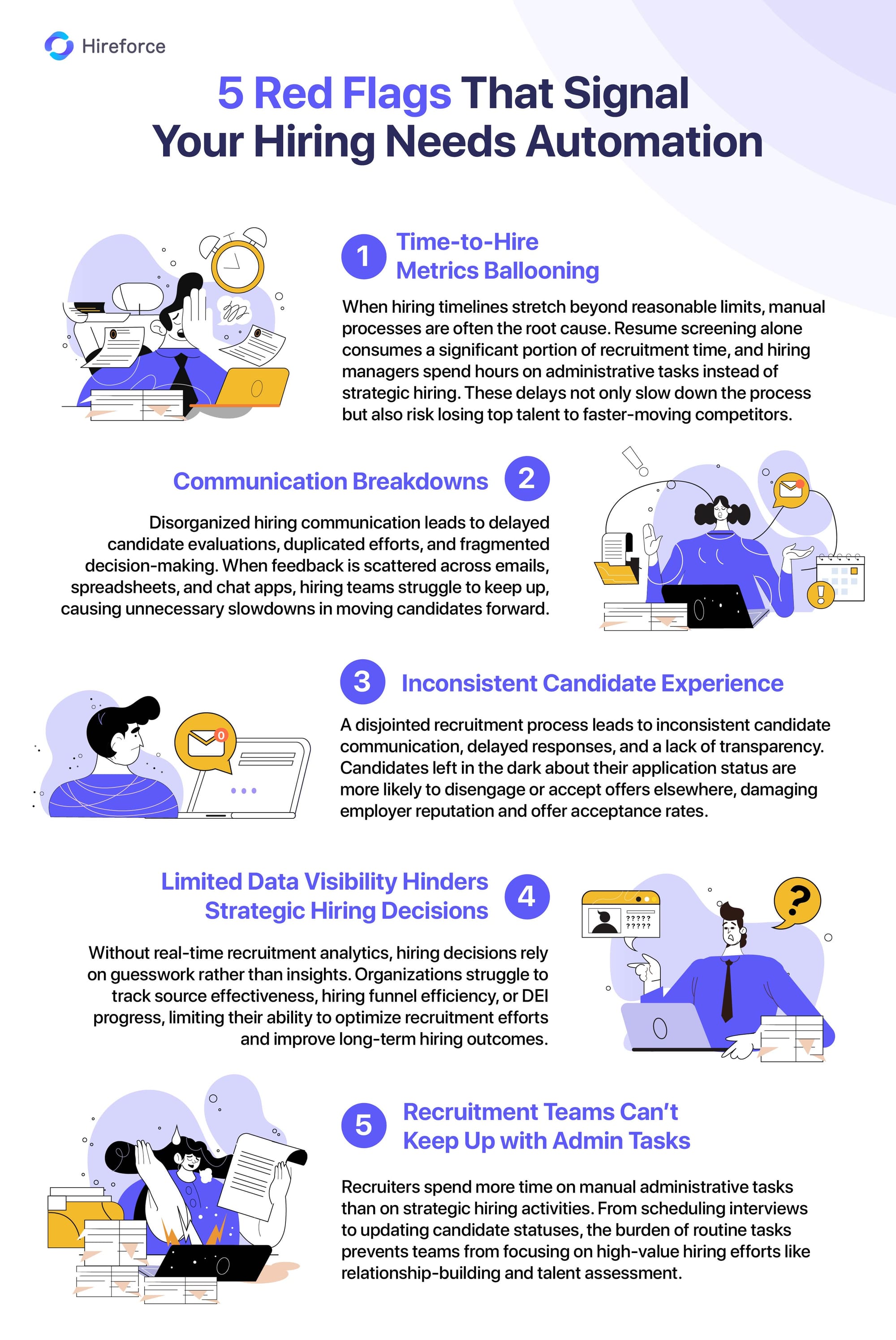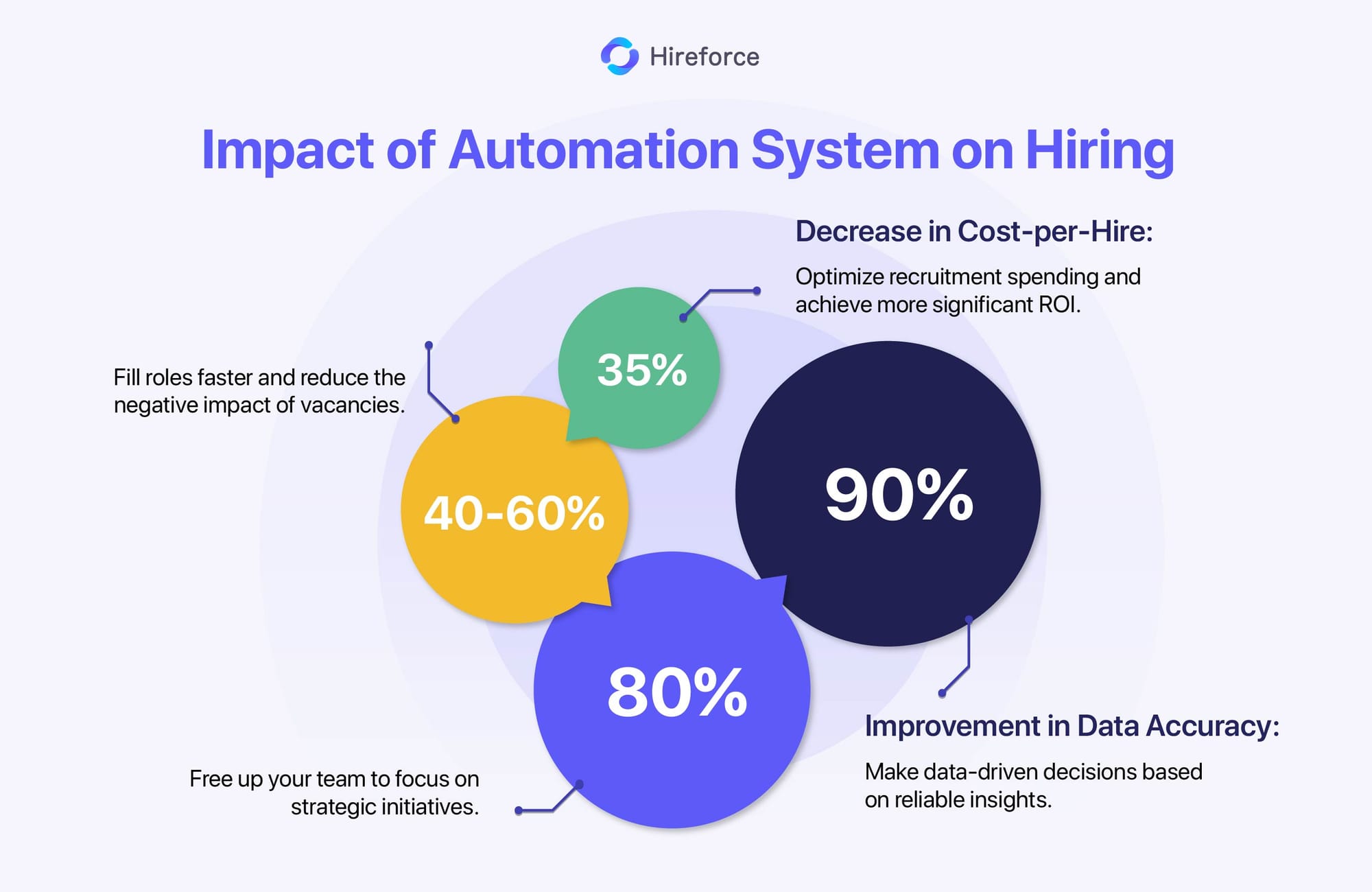The implementation of automation systems in work management has a long history, dating back to the 1920s. In the current era, with the boom of AI technologies like ChatGPT by January 2023, AI and automation, more broadly, have become an indispensable facet of all business activities. This is particularly true in the realm of recruitment, where the acquisition of talented personnel can propel a business forward, while the selection of unsuitable candidates can result in immeasurable losses. This detailed analysis will reveal 5 signs that your recruitment processes need to be automated.

1. Time-to-Hire Metrics Ballooning
When your hiring timelines stretch from weeks to months, it's a clear sign that manual processes are the bottleneck. The clock is ticking, and the longer it takes to fill a role, the more detrimental it becomes to your organization's success. For teams grappling with high-volume hiring, these delays are exponentially compounded. Imagine hiring managers, your key decision-makers, spending upwards of 15 hours per week – almost two full workdays! On tedious administrative tasks like sifting through resumes, scheduling interviews, and chasing down feedback.
2. Communication Breakdowns
It's super important for everyone to be on the same page when hiring someone new, but things can get messy if communication isn't organized. When feedback and reviews are all over the place in emails, chats, and spreadsheets, it makes the whole process confusing and slow:
- Delayed Candidate Evaluations: Crucial feedback gets lost in the digital abyss or buried under conflicting opinions, leading to agonizing delays in moving candidates forward.
- Duplicated Efforts: Multiple team members unknowingly perform the same tasks, wasting precious time and resources.
- Information Silos: Hiring managers operate in the dark, lacking access to the complete candidate picture, hindering informed decision-making.
- Lost Context: When new team members join the hiring process, the lack of a centralized information hub forces them to reconstruct the candidate's journey, leading to further delays and potential misjudgments.
These breakdowns don't just slow things down; they actively sabotage your ability to quickly identify and secure the best talent.
3. Inconsistent Candidate Experience
Manual processes, by their very nature, introduce inconsistencies and variability in how candidates navigate your pipeline. This is detrimental to your company's success. An analysis of candidate feedback exposes common pain points that can have a chilling effect on your employer brand:
- Delayed or Missing Application Confirmations: Candidates are left in limbo, wondering if their application has even reached its destination.
- Inconsistent Follow-up After Interviews: Some candidates receive prompt communication, while others are left hanging, creating a sense of unprofessionalism.
- Lack of Transparency About Application Status: Candidates are kept in the dark about where they stand, leading to frustration and anxiety.
- Variable Response Times Between Hiring Stages: Inconsistent communication timelines create a disjointed and unpredictable experience.
The negative consequences of these experience gaps are substantial and measurable. They not only leave a bad impression but also directly decrease the rate at which offers are accepted and harm your employer brand's reputation, making it harder to recruit top talent in the future.
4. Limited Data Visibility Hinders Strategic Hiring Decisions
Manual recruitment processes often lack the ability to provide crucial insights for strategic hiring, even though they may capture basic metrics. Without the data-driven intelligence offered by automation, important data points are often overlooked, and decisions are made based on intuition instead.
5. Recruitment Teams Can’t Keep up with Admin Task
The efficiency of recruitment teams can be significantly hampered by administrative tasks, particularly during periods of high demand. These tasks divert valuable time and resources away from core recruitment activities, such as candidate assessment and interviewing, and strategic initiatives, like performance analysis and planning.
Examples of such time-consuming administrative tasks include:
- Calendar Coordination: The constant juggling of schedules to arrange interviews.
- Application Status Updates: Manually informing candidates about the progress of their applications.
- Document Collection and Organization: The laborious task of gathering and managing resumes, cover letters, and other applicant documents.
- Interview Scheduling: Coordinating availability between candidates, interviewers, and hiring managers.
- Candidate Communication Logs: Manually keeping track of all interactions with candidates.
The Impact of Automation: Quantifiable Results
The automation of recruitment workflows results in significant time and cost savings, with a 40-60% faster time-to-fill and a 35% reduction in cost-per-hire. This increased efficiency allows companies to minimize the negative impact of prolonged vacancies and optimize their recruitment spending.
By streamlining 80% of recruitment tasks, automation frees up HR teams to focus on more strategic initiatives, while a 90% improvement in data reliability enhances hiring accuracy and enables more informed decision-making. Overall, automation not only helps businesses hire the best talent faster but also creates a more sustainable and scalable hiring strategy.
» The Impact of Automation: Quantifiable Results for ATS

Conclusion
In the competitive landscape of talent acquisition, automation is the driving force behind successful recruitment strategies. Companies still relying on outdated manual hiring processes risk falling behind. Embracing automation leads to faster role fulfillment, cost reduction, and data-backed decision-making, allowing HR teams to focus on strategic initiatives.
To stay ahead, companies should evaluate their existing hiring processes and pinpoint areas where automation can optimize efficiency. Implementing solutions that enhance communication, centralize candidate information, and generate actionable insights should be a top priority. A well-implemented automation strategy not only improves hiring but also bolsters employer branding, elevates candidate experiences, and ensures long-term growth. Companies that take proactive steps to automate their recruitment processes will secure a competitive edge and attract top talent.




